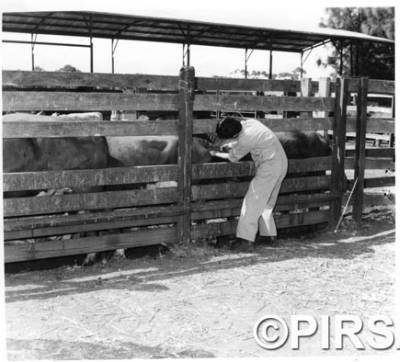Brucellosis and Tuberculosis Eradication (BTB)
A detailed analysis of the eradication of BTB is given in “Beating the Odds” by Robert Lehane in which he has drawn together the background and achievements of eradicating the diseases from Australia.(Lehane Robert, Beating the odds in a big country:, CSIRO Collingwood Victoria, 1996) Having successfully eradicated pleuro pneumonia and, with threats from Europe in 1965 that markets would be impacted, it was agreed nationally to tackle brucellosis and tuberculosis.
The presence of tuberculosis (TB) was known in 1859 and efforts followed to eradicate it from milking herds. This was due to the bacterium in cattle being closely related to those responsible for human and avian TB. TB was a distressingly common disease particularly in children. A campaign was mounted to rid it from dairy herds following the Second World War which resulted in it being down to a very low level in dairy herds across Australia by 1970.
In July 1970 compulsory testing of all South Australian herds with more than five head of cattle six months of age or older was announced. By 1974–75 250,000 cattle were being tested annually with 0.15% testing positive in that year down from 0.3–0.5% in the early 1970s. By the end of 1975 southern South Australia had achieved provisionally free status.

Photo No.: 103699 Title: Dr. Koh feeling the anal fold for a Tuberculosis reaction. Date: 13 Nov 1970
In 1975 tailtags were introduced and all cattle were bled in abattoirs to allow testing for TB and brucellosis and trace back to property of origin. This was to identify and ensure testing of herds where reactors occurred and eventually to confirm the disease status of a region, the State and finally the nation when no positives were found. Lehane relates numerous personal experiences and complicating issues such as breakdowns and cross infections with birds or deer creating difficult challenges for the campaign.(Neumann GB & Curran GC, A Review of the Brucellosis and Tuberculosis Campaign in Pastoral Areas of South Australia; SA Department of Agriculture Technical Report 42, (1983))
Eradicating TB in northern Australia was an amazing achievement and South Australia’s northern pastoral area was a part of that challenge. Facilities were poor, fences often non existent and seasons unpredictable. With South Australia’s northern campaign based at Port Augusta from 1976, the teams of veterinarians and stock inspectors were able to concentrate on the area. TB and brucellosis were then tackled jointly. Guidelines specific to the north were developed, including economic impact of destocking properties versus eradication testing, having stock inspectors carry out the testing and the utilisation of low level Strain 19 vaccinations for brucellosis infected herds. With changes to income tax laws to make construction of specific yard and fence facilities tax deductible where agreed plans were in place allowed progress to be made. An extensive report on the progress of the eradication campaign in the north can be found in Technical Report No. 42 () prepared by Neumann and Curran.
Helped by a drought and reasonable cattle prices many stations destocked to the extent that provisional freedom for both diseases was achieved in 1985. On stations being destocked up to 50% more cattle were mustered than the owners believed were present and the new fencing, yards and improved road transport changed property management in the area for ever.
Unlike TB, brucellosis, as a human health problem, was always principally an occupational concern for meat workers, farmers and particularly those working in dairies succumbing to undulant fever. In cattle the brucella abortus bacteria caused abortions in cattle.
In South Australia in 1970, free Strain 19 vaccine was made available to reduce the incidence of brucellosis after survey testing of herds established the level of infection. Extensive testing commenced in the southern areas of the State in November 1976 involving taking blood samples, testing them in a laboratory and then slaughtering any positive reactors. Laboratories in Adelaide and Struan (SE) processed more than 600,000 samples a year during the peak of the campaign. Southern South Australia became provisionally free of brucellosis in 1981. Action then moved to mop up the remaining herds in the north of the State with the last known case detected in 1985 leading to NSW, Victoria and SA being declared free of brucellosis in early 1988.
TB, brucellosis and pleuro-pneumonia are now all exotic diseases in Australia, giving a distinct marketing edge internationally but also with it responsibility to be vigilant to ensure they never arrive on our shores again.
Brief summaries such as this completely miss the personal hardship that such long and difficult campaigns imposed on cattlemen, Departmental staff and the cattle themselves.
